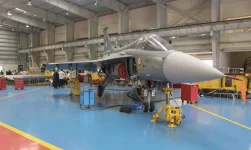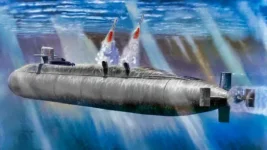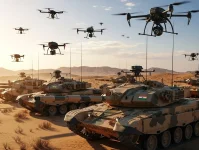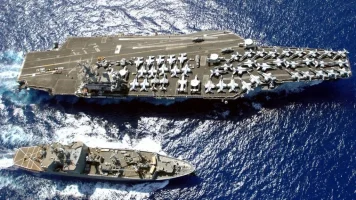- Views: 3K
- Replies: 6
State-owned aerospace manufacturer Hindustan Aeronautics Limited (HAL) is significantly advancing its production plans for the Combat Air Teaming System (CATS) Warrior, an unmanned aerial vehicle designed to operate alongside crewed fighter jets.
To meet a potential production target of approximately 100 units per year, HAL is actively expanding its collaboration with private sector suppliers. This initiative is driven by the drone's cost-effectiveness and growing interest from the Indian Air Force (IAF), which anticipates placing substantial orders for the system, although final numbers await formal evaluation.
The CATS Warrior, showcased as a full-scale demonstrator model during the Aero India 2025 exhibition, marks a key development in India's indigenous unmanned aircraft capabilities.
Conceived as a 'force multiplier', the drone is intended to augment the operational effectiveness of the IAF's existing fighter fleet, which includes aircraft like the domestically produced Tejas and the imported Su-30 MKI and Rafale jets.
Its roles are expected to range from undertaking strike missions deep into contested areas to providing protection for the manned aircraft it accompanies.
Supporting this ambition, HAL is building partnerships with private firms, capitalising on their expertise in areas such as composite materials, advanced electronics, and precision engineering.
A notable step in this collaboration was Tata Advanced Systems delivering a CATS Warrior airframe structure prototype to HAL in February 2025, indicating the development of a capable supply chain.
A crucial element making the CATS Warrior attractive is its projected unit cost, estimated between $5 million and $10 million. This contrasts sharply with the cost of modern manned fighter jets, which can range from $50 million to over $100 million each.
According to an HAL official, this significant cost difference makes the drone a viable option for deployment in larger numbers, enhancing combat flexibility while reducing the financial burden on India's defence budget. The official also emphasised that engaging more private sector suppliers is essential for achieving efficient, large-scale production.
For the IAF, which currently operates 31 fighter squadrons against a government-sanctioned requirement of 42, the CATS Warrior is viewed as a potentially transformative capability enhancer.
The operational concept for the CATS Warrior involves 'manned-unmanned teaming,' where a pilot in a conventional fighter aircraft could control and coordinate a small group, perhaps three or four, of these unmanned Warriors.
These drones could then be assigned tasks such as reconnaissance, launching precision attacks, or conducting electronic warfare, thereby increasing the mission's overall impact while minimising risk to the human pilot.
This approach aligns with similar development programs globally, including the United States' Skyborg initiative and Australia's MQ-28 Ghost Bat project, reflecting a growing trend in air forces worldwide to integrate unmanned systems to counter increasingly sophisticated air defence threats.
HAL projects that once production reaches full scale, its facilities could produce up to 100 CATS Warrior units annually. This capacity could potentially meet the IAF's domestic requirements while also opening possibilities for future exports.
The development and production involve a network of private companies supplying components, working alongside HAL's internal research and design centres, such as the Strategic Electronics Research & Design Centre (SLRDC) and the Aircraft Research & Design Centre (AERDC), which are developing key systems including the engine. This distributed model aims to leverage expertise across India's defence industrial base.
Despite the progress and positive outlook, the ultimate success and scale of the CATS Warrior program depend heavily on its performance in upcoming trials conducted by the Indian Air Force. These critical evaluations are expected to commence following the aircraft's maiden flight, anticipated sometime in late 2025 or early 2026.
The IAF will rigorously assess key performance aspects, including the reliability of its Autonomous Take-Off and Landing (ATOL) system, its mission payload capacity, and the effectiveness of its secure data links for seamless integration with manned fighter platforms. Positive outcomes from these trials could lead to firm orders for hundreds of units, significantly reshaping the IAF's future operational strategies.




